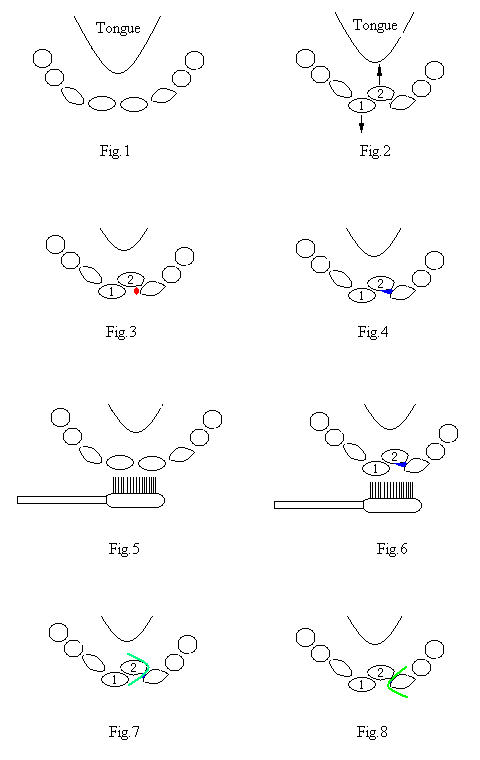
|

|
Dental Education Lecture: Why Do My Gum Bleed Just in One Area?
Last week a young pretty lady came to my office for cleaning. Although she is nervous about dental work, she is concerned about gum bleeding in one particular tooth: a lower front tooth. Let us use drawing to show why it happens and how to prevent it.
Fig.1 is a biting view of our lower teeth in a normal alignment. Fig.2 shows that our teeth are not so well-aligned. The lower front teeth are crowded and overlapping. While the tooth labeled as 1 is drawn below (labially, toward our lip, lower arrow), the tooth labeled as 2 is pushed above (lingually, toward our tongue, upper arrow).
A casual look at her mouth reveals that she keeps her teeth clean and white. However, careful exam shows that in one particular area, the gums in the labial surface of the tooth 2 are reddish, swollen, and bleeding (gingivitis, red spot in Fig.3). There is heavy plaque and tartar deposit in the inflamed area between the tooth 2 and its next door neighbor (tooth) (blue spot in Fig.3).
Regular toothbrushing can do decent job for non-crowded teeth (Fig.5), whereas it may not be able to remove plaque and and tartar in the dead corner (Fig.6).
Only diligent flossing can get rid of the nasty thing (Fig.7 and 8). But you have to do it painstakingly on a daily basis.
The more efficient way is to have braces to fix the crowding problem, alleviating daily work.
Untreated gingiviits may lead to periodontitis, losing one or several teeth.
Xin Wei, DDS, PhD, MS 1st edition 06/28/2009, last revision 07/03/2009